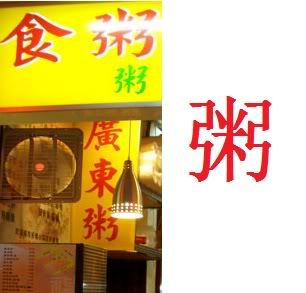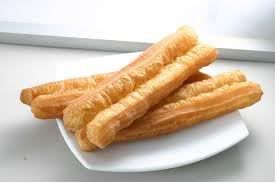One of my favorite things to do on a cold winter’s day is go to Chinatown for a big bowl of rice porridge. In New York City, we have several amazing places to get it.
Since it’s not really popular among non-Chinese visitors to Chinatown, you don’t see it on most menus, so you have to go to the smaller, “more-Chinese” restaurants. Often you’ll see the character of it hanging or flashing in the window. 
A truly pan-Asian dish, the word Congee is not Chinese but comes from south India. The Cantonese call it JOK and Mandarin speakers call it either JYOU or SHE FAN.
Congee couldn’t be any simpler. It’s just boiled rice that stays soupy. When it boils for hours, it gets very creamy and the rice kernels almost disappear.
Depending on where the owner of the restaurant comes from, your bowl of Congee will vary slightly. Simple Congee can be served with just slivered ginger and chopped scallions. And then, some add pork or beef with cilantro, and some add PI DAN which is preserved egg also known as Thousand Year Old Egg.
To a western eye, the egg looks, well frankly gross, but try it because you’ll be surprised how delicious it is. In Taiwan, they serve it with sweet potatoes boiled inside, and in Japan, they add in various types of pickles and even dried fish.
Another very popular addition to Congee is YO TIAO or fried dough sticks. Usually, they are cut into smaller, bite-sized pieces and garnish the top of your rice porridge.
 I make Congee often at home during the colder months and sometimes, I simply eat it with a fried egg along with some scallions sprinkled on top. As do some Chinese, I also like to add some vinegar and/or sesame oil as well. And if I’m feeling spicy, a big heaping spoonful of chili sauce can also give it a nice kick.
I make Congee often at home during the colder months and sometimes, I simply eat it with a fried egg along with some scallions sprinkled on top. As do some Chinese, I also like to add some vinegar and/or sesame oil as well. And if I’m feeling spicy, a big heaping spoonful of chili sauce can also give it a nice kick.
However you end up eating it, you will most certainly look up at the waiter and in your best Oliver voice say “Please Sir can I have some more!”

Robert Aiudi, a.k.a., The Language Chef, has been known to his friends and family as a “language junkie” nearly his entire life. He is fluent in many, conversational in others and can fake it through another large amount of some of the most exotic languages in the world. He has taught and tutored many happy students, and annoyed people over the years by asking “how do you say that?”.
From his young years surrounded by speakers of three different dialects of Italian, to university in France and German and extensive work in Asia, China, Taiwan, Japan, Robert has picked up languages and breathed in the cuisines of many countries. Translating from 27 languages into English, Robert is a repository of anecdotal and factual information about languages of all sorts which adds flavor and depth to the Language Chef.
An expert amateur cook, Robert has worked in Paris in small bistro, made pizzas in Florence, wrangled recipes out of the hands of German grandmothers in the Black Forest, worked in a Chinese restaurant and had ad hoc cooking lessons in restaurants in China, Taiwan and Japan as well as various Chinatowns. Most importantly, Robert, his mom and dad, two grandmothers and lots of aunts from Italy have made culinary magic in their kitchens for generations.








